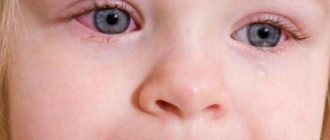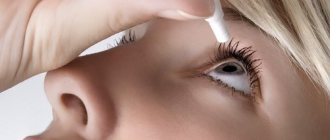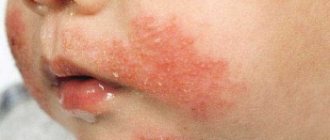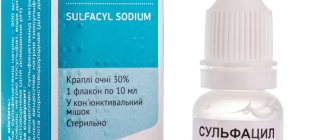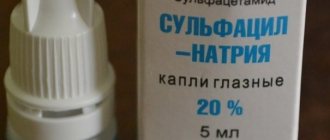Types of disease and ointments for conjunctivitis
Both children and adults suffer from damage to the conjunctiva, which is accompanied by inflammation, swelling and redness.
Since there are many reasons that can provoke eye disease, there are several types of conjunctivitis:
- Bacterial. It occurs due to the penetration of bacteria into the mucous membrane of the organs of vision, and quite pronounced symptoms are observed. Usually one eye is affected. After waking up, it is quite difficult to open the eyelids due to the discharge of pus.
- Viral. If the pathology is caused by adenoviruses or the herpes virus, the patient must be isolated for a while, since he poses a danger to others. The disorder manifests itself in the form of severe hyperemia of the eyes, infiltrates on the mucous membrane, and the formation of films that are easily removed.
- Allergic. It can develop due to contact with various irritants. The insidiousness of the pathology is that it can occur against the background of bacterial or viral conjunctivitis, as a reaction to the medications used.
- Fungal. It is caused by pathogenic fungi or existing systemic infections, such as candidiasis.
Treatment of conjunctivitis of various origins cannot be carried out with the same drugs . When prescribing a medicine against an illness, the doctor must take into account the type and origin of conjunctivitis . The list of effective means is quite large.
In particular, it is represented by the following ointments:
- tetracycline, erythromycin, oxolinic;
- Tobrex;
- Phloxalom;
- Levomycetin;
- Acyclovir;
- Hydrocortisone;
- Solcoseryl;
- Dex-Gentamicin;
- Zovirax;
- Tobradex;
- Cortineff;
- Garazon and so on.
It is not advisable to carry out treatment without medical advice. The success of therapy depends on determining the nature of conjunctivitis and correctly prescribing appropriate therapy.
Use of eye ointments in adults
To cope with conjunctivitis in adults, the eye ointment must be selected correctly. In addition to the age category and etiology (cause) of the disease, the following is taken into account:
- pregnancy and breastfeeding period;
- allergic status;
- diseases in the anamnesis, which were characterized by a severe course.
Therefore, the independent use of medications for damage to the conjunctiva can be dangerous for eye health and the development of complications. What ointment is suitable for conjunctivitis in adults?
Effective tetracycline eye ointment for conjunctivitis
The name of the drug is familiar to many patients because it is often prescribed against pathologies of bacterial origin. The duration of the course depends on the severity of the symptoms. Like all antibacterial drugs, Tetracycline has contraindications. It is prohibited for pregnant women and those with infants, as well as for patients with intolerance to the components. Appointed from the age of 8.
Acyclovir ointment - help with infection
A fairly effective medicine that can be used to treat viral conjunctivitis. Acyclovir is the main active component, quickly penetrating into foci of infection and eliminating the characteristic symptoms of a viral infection. The advantage of the product is that it acts locally, so there are no serious restrictions or adverse reactions.
Oxolinic ointment - features of use
A drug with an antiviral effect copes well with the signs of adenovirus infection and herpes infection.
Due to the presence of tetraxoline in the composition, it slows down the reproduction of the pathogen, preventing its further development.
The substances present in the medicine do not penetrate into the bloodstream, acting only on the area affected by the infection. During treatment, the patient may experience pain, itching and burning, but they are temporary and pass quickly.
Erythromycin ointment - instructions for use
One of the most popular remedies prescribed to eliminate bacterial types of pathology. The drug is indicated for use not only in adults, but also in very young children. The more severe the disease, the longer the therapeutic course lasts.
The drug is well tolerated, although in some cases erythromycin ointment can cause allergic reactions.
Hydrocortisone ointment - help with the problem
A life-saving remedy for severe allergic reactions of the organs of vision. Contains a glucocorticosteroid. It has properties to reduce the intensity of inflammatory and allergic processes, reduces swelling locally.
Ointments for the treatment of viral conjunctivitis
For the viral form of the disease, non-steroidal ointments are used that can quickly remove inflammation of the mucous membrane of the eye.
Acyclovir
The drug with an antiviral effect contains acyclovir sodium salt. The active substance easily and quickly penetrates the corneal epithelium, where it creates a therapeutic concentration in the tear fluid. Apply every four hours and continue until completely cured. Acyclovir is recommended to be used together with immunostimulating drugs. With proper external use, there can be no overdose. Rarely appear as side effects:
- keratopathy;
- irritation of the mucous membrane;
- allergy.
Oksolin
Eye ointment is used for keratoconjunctivitis and keratitis of viral origin. It has a virucidal effect against herpes simplex virus and adenovirus. When applied externally, the drug is not absorbed and does not accumulate in the body.
Treatment is carried out by placing ointment in the eyes every six to eight hours for seven days. If after a week there is no positive effect from therapy, you should consult a doctor.
It is not recommended to use oxolin during pregnancy, lactation and individual intolerance to the components of the drug. Side effects:
- minor burning and irritation of the skin after applying the ointment, which quickly disappear;
- in rare cases, allergic reactions in the form of itching, severe burning, swelling and redness of the mucous membrane.
Florenal
Vaseline-based antiviral ointment has the active substance fluorenonylglyoxal bisulfite. Used for herpetic eye infections.
For treatment in the first days of conjunctivitis, the ointment is applied three times a day. After using the drug, it is reduced to twice a day. The therapeutic effect should occur within seven to ten days.
The only contraindication is hypersensitivity to Florenthal. Side effects are very rare and may include:
- eyelid dermatosis;
- lacrimation;
- burning;
- sensation of a foreign body in the eye.
Eye ointment for children - list of medications and their effectiveness in childhood
The mucous membrane of the eyes in children suffers very often. The infection is usually acquired through dirty hands, because it is still difficult for children to understand the importance of personal hygiene. To effectively treat conjunctivitis, appropriate medications are selected, among which eye ointments occupy a special place, as they act locally, directly on the affected area.
Before using the product, you must carefully study the instructions supplied with it to become familiar with the age restrictions. Which ointment to choose for conjunctivitis for children? There are drugs whose use is permitted only from 8 years of age (tetracycline ointment, Colbiocin).
Ointments that can be used to treat newborns
Typically, conjunctivitis in newborns is the result of infection while the baby is in the womb or at birth. If a woman is a carrier of, for example, chlamydia, the infection will reach the child during pregnancy or childbirth, causing damage to the mucous membrane of the eyes.
Often the conjunctiva of babies suffers from non-compliance with basic hygiene rules by the mother herself or the medical staff. There is also an allergic type of the disease.
The following ointments are used to treat conjunctivitis:
- Erythromycin. Has a pronounced bacteriostatic effect. Well tolerated by children under one year old. If there is intolerance to the components, the medicine is not prescribed.
- Phloxal. An antibiotic that effectively fights gram-negative bacteria.
- Tobrex. Used from 2 months of age against various types of bacterial conjunctivitis.
- Florenal. An antiviral drug that causes almost no side effects. Helps cope with herpes infection and adenoviruses.
In the presence of severe allergic conjunctivitis, the irritant is first determined. Treatment is carried out using hormonal or corticosteroid drugs (hydrocortisone ointment).
Treatment of children 2 years old and 3 years old
If a 2-year-old child is exposed to a viral infection, Acyclovir or Zovirax may be used. The course lasts from 5 to 10 days. The best ointments for bacterial infections are erythromycin or chloramphenicol. Such preparations have a disinfectant, bactericidal, anti-inflammatory and soothing effect. If a child 2-3 years old has renal or liver failure, as well as individual intolerance to the components, chloramphenicol ointment will not be recommended.
Antiallergic eye ointments
Allergic (non-infectious) conjunctivitis is accompanied by lacrimation, burning, and intense itching. The child is capricious and crying. A common form in children is spring hay fever.
House dust, pet hair and fluff, and household chemicals are also allergens. Contact conjunctivitis develops in children when wearing corrective eye lenses.
In the treatment of allergic conjunctivitis, elimination of the allergen irritant is of great importance.
Combined anti-inflammatory drugs and hormonal drugs are used under the strict supervision of a doctor. The combined drug dexa-gentamicin (contains the hormone dexamethasone and the antibiotic gentamicin) is contraindicated in children under 18 years of age.
Tetracycline - does the drug help?
Most ophthalmologists approve of the use of this medicine for inflammation of the eye mucosa due to damage by pathogenic bacteria . The main thing is to remember about contraindications, because not all patients can use the drug.
The product contains tetracycline hydrochloride. Thanks to the proper use of the drug, it will be possible to suppress the proliferation of pathogens at the protein level. The drug acts gently, without causing unpleasant sensations in the form of painful discomfort, pain and burning.
Using the product helps:
- eliminating the inflammatory process;
- eliminating bacteria that caused the disease;
- active restoration of affected tissues.
Therapy can only be carried out from 8 years of age. To complete the course of treatment, one tube is enough. After opening it, you can use it for no longer than 2 months.
The drug has repeatedly proven its effectiveness, and the patient’s body often tolerates it well. However, occasionally allergic manifestations cannot be ruled out.
Patients interested in the question of whether an antibiotic helps with conjunctivitis should know that if its use does not bring the desired results in the first days, it is necessary to seek help.
Contraindications
It is important to take into account the fact that tetracycline ointment is a first-generation drug; it was actively used in the 50s and 60s. last century. Many infections have adapted, which explains the low effectiveness of treatment in some cases.
In addition, the newest analogues (Colbitsion, Tobradex, Fucithalmic, Zovirax, Hydrocortisone, etc.) have fewer side effects and contraindications, act gently and quickly, which affects the effectiveness and speed of recovery.
Tetracycline ophthalmic ointment is prescribed quite often. When using the product, you need to take into account the limitations and contraindications:
- intolerance to tetracycline antibiotics,
- fungal infections,
- kidney disease,
- liver dysfunction,
- low level of leukocytes in the blood,
- gastric and intestinal disorders (gastritis, ulcers, etc.).
Possible negative reactions of the child’s body to the ointment:
- loss of appetite,
- nausea (to the point of vomiting),
- diarrhea,
- allergies (itching, skin rash, in clinical cases angioedema, increased sensitivity to bright light, etc.),
- complication of the teething process (pain, anxiety),
- staining tooth enamel in a yellowish-dirty color.
How to apply ointment correctly
Treatment of conjunctivitis involves not only the correct selection of the appropriate drug, but also its competent use. Many people simply do not know how to apply the ointment behind the eyelid, especially if the baby needs help.
The procedure consists of certain stages:
- Before starting manipulations, hands are thoroughly washed with soap.
- The sore eye is treated with a disinfectant solution, for example, a solution of Furacilin or Chlorhexidine.
- A small amount of the product is applied to a disposable cotton swab or the glass spatula included with the product.
- After retracting the eyelid, you must carefully fill the conjunctival sac with the product.
- Next, close your eyes and lightly massage your eyelid. This will soften the medicine and distribute it well.
- Excess composition is removed with a cotton swab or disk.
It is possible to perform manipulations without using a spatula. The product is squeezed out of the tube into the conjunctival sac, and it is important that the tip of the tube does not touch the surface of the eyeball. The smallest babies are allowed to lay down while they are sleeping.
During the first minutes, visual acuity may decrease, and tearing may also occur. If the procedure is performed correctly, the discomfort will soon disappear.
How to use drugs during pregnancy
To successfully recover from conjunctivitis, you cannot do without an integrated approach. However, it is dangerous for pregnant women to use many medications, so it is prohibited to carry out therapy without consulting a doctor.
Despite the impressive list of eye medications that can weaken and eliminate the infection in a matter of days, expectant mothers should exercise caution when choosing the right medication.
The drug for women bearing a child is prescribed taking into account the etiological factor and the duration of pregnancy.
The list of eye medications is presented:
- Erythromycin ointment. Thanks to the presence of erythromycin, which is the main active ingredient, it is possible to stop the activity of bacteria, both gram-positive and gram-negative.
- Tebrofen. The drug successfully fights the signs of illness caused by herpes infection or adenovirus. Proper use of Tebrofen helps eliminate symptoms within 3-5 days.
- Acyclovir. After application, the product is perfectly absorbed by the cells of the eye, which virtually eliminates the occurrence of adverse reactions.
- Zovirax. The composition, getting on the affected area, creates an unfavorable environment for pathogens.
- Maxidex. It has anti-inflammatory, antiallergic and desensitizing properties.
- Hydrocortisone. During treatment, minimal dosages are prescribed due to the presence of the hormone hydrocortisone. Exceeding the dose may adversely affect the development of the fetus.
When prescribing medications, the doctor takes into account all possible risks.
